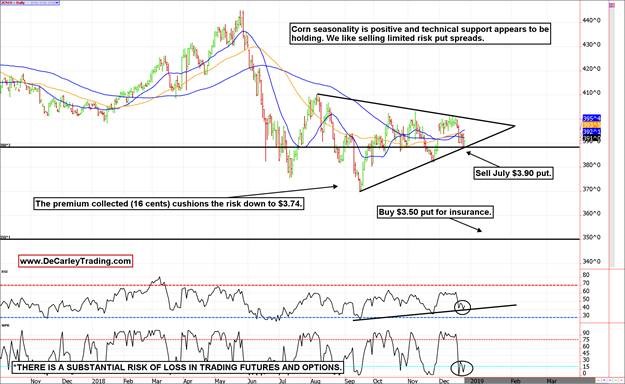Although the practice of option selling isn’t necessarily a popular strategy due to the idea of unlimited risk tied to a limited reward, we encourage traders to keep their eyes and minds open, says Carley Garner Thursday. Consider corn. Video: How to hedge with futures.
The great aspect of options trading is the ability to create a speculative position with unlimited combinations of risk and reward.
In other words, option selling doesn’t have to come with unlimited risk. Instead, traders can use long options to spread their risk and limit exposure to adverse price moves. Let’s take a look at an example.
According to MRCI data, the overall direction of corn should be higher in the coming weeks. Further, the uptrend line and market fundamentals appear to be pointing toward stable to higher prices. As contrarians, we also like the fact that merely 35% of those polled by Consensus Bullish Index believe corn prices will move higher and according to the COT report, large traders are moderately long but have yet to deploy the majority of their resources (there could be sidelined money coming into the long side of corn).
We’ve been patiently waiting for corn prices to relax enough to justify playing the upside. While we are disappointed at the lack of option premium available to sell, we also acknowledge that the cheap options enable traders to establish put spreads with reasonable risk.
Although we are bullish in corn, we also recognize the market is not exactly oversold. Nor is it showing immediate signs of sharp buying. Thus, we believe speculations in this market should be tame.
We like the idea of selling the July corn $3.90/$3.50 put spread (go short the $3.90 and go long the $3.50 to limit risk). The result is a net credit of roughly 15 to 16 cents or $750 to $800. This represents the maximum profit potential before considering transaction costs.

The total risk is about $1,200 before considering transaction costs. While anything is possible, it doesn't seem likely to incur the maximum loss.
For this to happen, July corn would need to be below $3.50, a price the contract has yet to see in its lifetime (this particular contract anyway). Also, the net credit collected will cushion the risk to $3.74, which nearly protects the position to the contract low of $3.70.
In essence, this the trade can be wrong by the amount of premium collected for the spread (16 cents in this example) before money is lost at expiration. If the price of July corn is above $3.74 at expiration, the trade pays off something; if it is above the current price of $3.90 (whether it is $3.9025, $4.00, or $5.00) the trade pays off the premium collected (about 16 cents or $800). As you can see, an option seller doesn’t have to be right to make money, he simply can’t be “too wrong.”
For those questioning why a trader would willingly accept a $1,200 risk prospect for a potential return of $750, the answer is probability. Most options erode in value to eventually expire worthless; thus, the seller of options already has a bit of an edge. Further, corn is historically cheap leaving significant declines from current levels unlikely. In other words, high probability option selling strategies will work more than they don’t, which makes the risk and reward profile offered by this venture attractive.
The exchange minimum margin required to initiate this trade is about $384 which means a trader is putting up $384 in a good faith deposit to leverage a position that could possibly make twice as much.
However, be mindful of which brokerage you are using to trade futures and options on futures. Many brokerages either forbid option trading (particularly premium collection) strategies, restrict products and product months available for trading, or charge higher margins to curtail the activity.
The reluctance of brokerages to provide a reasonable environment for such strategies is because many online traders don’t have the basic knowledge to identify and manage risks; this puts a larger burden on the brokerage. In short, when choosing a proper brokerage to handle such trades, the focus shouldn’t be on platform or commissions, it should be on their capability of offering a conducive environment for options trading.
Because I lean toward option selling strategies but encourage hedging all risk via the use of spreads, my brokerage (DeCarley Trading) specializes in such services.
Options trading, and particularly option selling strategies, are not for everyone. It is imperative that traders have a good handle on these types of strategies prior to partaking in them. Also, these types of positions are highly speculative in nature; they are trades, not investments.
There is a substantial risk of loss in trading commodity futures, options, ETFs. Seasonal tendencies are already priced into market values.
Carley Garner is the Senior Strategist for DeCarley Trading, a division of Zaner, where she also works as a broker. Garner is best known for her contributions to Jim Cramer’s Mad Money; she authors widely distributed e-newsletters; for your free subscription visit www.DeCarleyTrading.com. She has written four books, the latest are the third edition of “A Trader’s First Book on Commodities” (October 2017) and “Higher Probability Commodity Trading” (July 2016).
View a brief video with Carley Garner: How to hedge with futures here.
Recorded: TradersExpo Las Vegas, Nov. 13, 2018.
Duration: 3:31.
View a brief video with Carley Garner: How to trade futures here.
Recorded: TradersExpo Las Vegas, Nov. 13, 2018.
Duration: 4:21.
View of brief interview of Carley Garner at MoneyShow Las Vegas: How I got started in trading.
Duration: 4:11
Recorded: May 15, 2018.





















